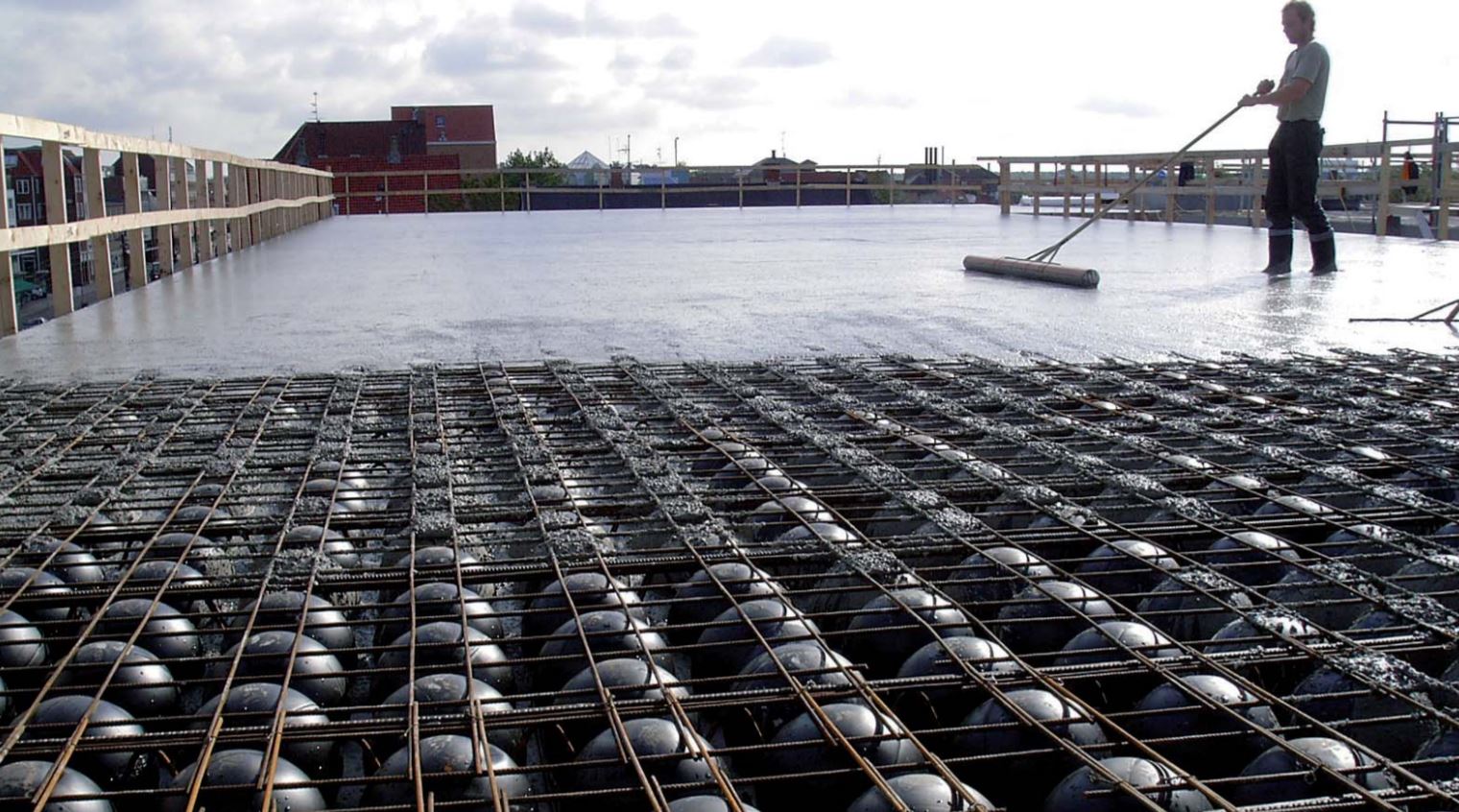Voided Biaxial Slab

Description
Voided biaxial slabs are like a flat slab, they both use cast in situ concrete, are reinforced the same way and both carry two ways. The only difference being that the voided biaxial slab has lightweight voided elements at mid height of the slab resulting in a about 30% lighter slab overall. This is structurally efficient because the middle part of a flat slab is the structurally least efficient part that mainly adds weight. Self-weight is a significant portion of the load on concrete slabs. The middle part is only important against shear force and that is usually only defining around columns due to punching shear. In that area the voided elements are not put in. Voided biaxial slabs start to become efficient for thicker slabs and thus for higher spans. The economic span range lays between 5 and 15 m, significantly higher than the one for flat slabs (0 - 10 m). Same as in flat slabs, voided biaxial slabs are usually made continuous to reduce deformations.
Voided biaxial slabs perform well against fire due to the high thickness and reaches a fire resistance of 120 min.
The flexibility is on site is as good as it gets, it can adapt to spontaneous changes without problems. Also, the geometric flexibility is good because one is not limited to rectangular floor shapes. However, a certain thickness must be given to use voided biaxial slabs and the more recesses are include in a slab, the less voided elements can be used, because they are optimised for standard applications. Building systems can be integrated without a problem. Since no special formwork or reinforcement is required the complexity is average. Installing the voided elements should not be an issue at all. The construction time is rather slow because formwork is required as well as reinforcement. Additionally, the time the concrete needs to cure also slows down construction. The installation of the voided elements does not slow down the construction speed significantly.
As in most concrete floors, vibration is not a concern due to the large weight.
For a square slab, the slenderness ration l/h lays around 32, but is dependent on the load and the amount of reinforcement included. This is significantly more slender than the flat slab.
Database
Floor type |
Voided Biaxial Slabs |
||
|---|---|---|---|
Materials |
concrete_reinforcement_voided elements |
||
Description |
hollow elements to reduce weight for rather thick slabs |
||
Way of carrying |
Does the main span carry in one or two directions? |
two way slab |
|
Span width low [m] |
Economically possible |
5 |
|
Span width high [m] |
Economically possible |
15 |
|
Additional measures when installing |
formwork_propping up |
||
Prefab? |
Is prefab possible? |
no |
|
Continous slab? |
Can you build the slab with supports in middle of the slab? |
yes |
|
Building systems integratable? |
Can buildings systems be included into the slab itself? |
yes |
|
Fire |
Fireresistance without costly measures [min] |
120 |
|
Substructure |
Certain prerequisites necessary? |
no |
|
Prone to vibration |
no |
||
Environment |
General classification including formwork |
1 to 5 terrible to very good |
3 |
Construction time |
Time on site |
1 to 5 very slow to very fast |
2 |
Flexibility |
Average of the next two |
1 to 5 |
4.5 |
Flexibility on site |
How flexible is the system to spontaneous changes on site? |
1 to 5 terrible to very good |
5 |
Flexibility geometry |
How good can you adapt the slab to complex geometries? |
1 to 5 not at all to very easy |
4 |
Complexity |
Average of the next two |
1 to 5 |
3 |
Complexity fabrication |
Complexity of floor itself. |
1 to 5 very complicated to very simple |
3 |
Complexity installation |
Complexity installation on site |
1 to 5 very complicated to very simple |
3 |
Slenderness l/h 3kPa |
Applied load (without selfweight) |
Residential building |
33 |
Slenderness l/h 4kPa |
Applied load (without selfweight) |
Office building |
31 |
Weight [kN/m3] |
per m2 and total height of slab |
18 |
|
Embodied energy [MJ/m3] |
per m2 and total height of slab |
4200 |
References
- General information:
Goodchild, C., Webster, R., & Elliott, K. (2009). Economic Concrete Fram Elements to Eurocode 2. Camberley UK: The Concrete Centre.
https://www.cobiax.com/ch/de/produkte/- Span width:
up to 16m (https://www.bba-online.de/fachthemen/innenausbau/grosse-spannweiten-mit-hohlkoerperdecke/#:~:text=Wabenf%C3%B6rmige%20Hohlk%C3%B6rperdecke%20f%C3%BCr%20gro%C3%9Fe%)
Example with 7m x 14m (https://www.bauingenieur24.de/fachbeitraege/massivbau/bubbledeck-die-zweiachsige-hohlkoerperdecke/982.htm)- Fire resistance:
120min (Goodchild, C., Webster, R., & Elliott, K. (2009). Economic Concrete Fram Elements to Eurocode 2. Camberley UK: The Concrete Centre.)
120min (https://www.structuremag.org/?p=12554)- Slenderness:
l/h=19 for 3kPa, l/h=19 for 4kPa (Goodchild, C., Webster, R., & Elliott, K. (2009). Economic Concrete Fram Elements to Eurocode 2. Camberley UK: The Concrete Centre.)
- Weight:
- Embodied energy:
- Photo Source: